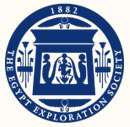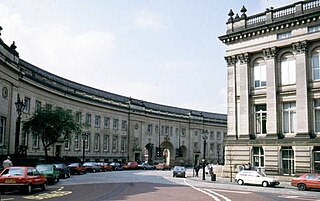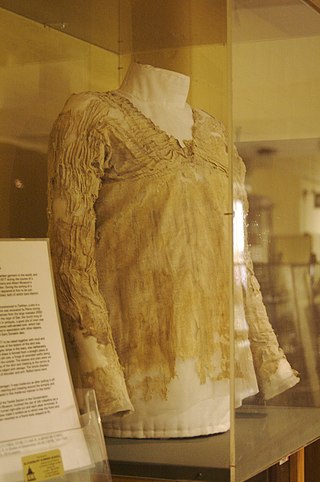
Nefertiti was a queen of the 18th Dynasty of Ancient Egypt, the great royal wife of Pharaoh Akhenaten. Nefertiti and her husband were known for their radical overhaul of state religious policy, in which they promoted the earliest known form of monotheism, Atenism, centered on the sun disc and its direct connection to the royal household. With her husband, she reigned at what was arguably the wealthiest period of ancient Egyptian history. Some scholars believe that Nefertiti ruled briefly as Neferneferuaten after her husband's death and before the ascension of Tutankhamun, although this identification is a matter of ongoing debate. If Nefertiti did rule as Pharaoh, her reign was marked by the fall of Amarna and relocation of the capital back to the traditional city of Thebes.

Mummy portraits or Fayum mummy portraits are a type of naturalistic painted portrait on wooden boards attached to upper class mummies from Roman Egypt. They belong to the tradition of panel painting, one of the most highly regarded forms of art in the Classical world. The Fayum portraits are the only large body of art from that tradition to have survived. They were formerly, and incorrectly, called Coptic portraits.

Sir William Matthew Flinders Petrie, commonly known as simply Sir Flinders Petrie, was a British Egyptologist and a pioneer of systematic methodology in archaeology and the preservation of artefacts. He held the first chair of Egyptology in the United Kingdom, and excavated many of the most important archaeological sites in Egypt in conjunction with his wife, Hilda Urlin. Some consider his most famous discovery to be that of the Merneptah Stele, an opinion with which Petrie himself concurred. Undoubtedly at least as important is his 1905 discovery and correct identification of the character of the Proto-Sinaitic script, the ancestor of almost all alphabetic scripts.

The Egypt Exploration Society (EES) is a British non-profit organization. The society was founded in 1882 by Amelia Edwards and Reginald Stuart Poole in order to examine and excavate in the areas of Egypt and Sudan. The intent was to study and analyze the results of the excavations and publish the information for the scholarly world.

El Lahun. It was known as Ptolemais Hormos in Ptolemaic Egypt.

Winifred Mabel Bruntonnée Newberry was a South African painter, illustrator and Egyptologist.

The Department of Ancient Egypt is a department forming an historic part of the British Museum, with Its more than 100,000 pieces making it the largest and most comprehensive collection of Egyptian antiquities outside the Egyptian Museum in Cairo.

Bolton Museum is a public museum, aquarium and art gallery in the town of Bolton, England, owned by Bolton Metropolitan Borough Council. The museum is housed within the grade II listed Le Mans Crescent near Bolton Town Hall and shares its main entrance with the central library in a purpose-built civic centre. The building has good accessibility.

Tarkhan is an ancient Egyptian necropolis, located around 50 km south of Cairo on the west bank of the Nile. The cemetery was excavated in two seasons by Flinders Petrie. Tombs of almost all periods were found, but most importantly many belonging to the time of Egyptian state formation, the Early Dynastic period around 3100 BC. Petrie found more than 2,000 tombs, most of them simple holes in the ground belonging to common people. However, there were also several mastabas of the First Dynasty, decorated with a palace facade.
Percy Edward Newberry was a British Egyptologist.
Stephen Quirke is an Egyptologist. He is the current Edwards Professor of Egyptian Archaeology and Philology at University College London. He has worked at the British Museum (1989–1998) and since 1999 at the Petrie Museum in London. He has published several books, some of them translated into other languages.
Gianluca Miniaci is an Italian Egyptologist, currently Associate Professor at the University of Pisa.

Hilda Mary Isabel, Lady Petrie, was an Irish-born British Egyptologist and wife of Sir Flinders Petrie, the father of scientific archaeology. Having studied geology, she was hired by Flinders Petrie at age 25 as an artist, which led to their marriage and a working partnership that endured for their lifetimes.

Kate Bradbury Griffith was a British Egyptologist who assisted in the early development of the Egypt Exploration Society and the Department of Egyptology at University College London (UCL). Bradbury was born in Ashton-under-Lyne, near Manchester, UK, to Elizabeth Ann Tomlins and businessman Charles Timothy Bradbury.
Violette Lafleur was a Canadian conservator and curator for the Department of Egyptology and Petrie Museum of Egyptian Archaeology, University College London.
Margaret Stefana Drower Hackforth-Jones MBE, known as Peggy Dower, was an English historian of Ancient Near Eastern History and Egyptology. She was awarded the MBE and elected a Fellow of the Society of Antiquaries of London. She wrote the definitive biography of Flinders Petrie.

The Tarkhan Dress, named for the Tarkhan cemetery south of Cairo in Egypt where it was excavated in 1913, is an over 5000 year old linen garment that was confirmed as the world's oldest piece of women's clothing.
Elise Jenny Baumgartel was a German Egyptologist and prehistorian who pioneered the study of the archaeology of predynastic Egypt.
Alice Stevenson is a British archaeologist and museum curator. She is Senior Lecturer in Museum Studies at UCL's Institute of Archaeology and a specialist in Predynastic and Early Dynastic Egyptian archaeology.
Jessie Mothersole (1874–1958) was an English archaeologist, artist, and author.

















